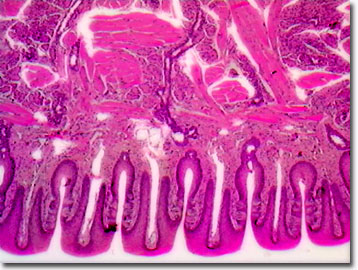Brightfield Digital Image Gallery
Mammalian Taste Buds
Being a gourmet chef or a gourmand is a matter of more than just good taste; it requires highly functional taste buds. The human mouth and nose feature thousands of different biochemical receptors that bind odorants and allow the brain to decode diverse signals for a plethora of tastes. In spite of the large number of receptors and codes, only five main tastes are distinguishable - sweet, bitter, sour, salty, and Umami (or Unami).

View a high magnification image of mammalian taste buds.
Traditionally, Western scientists have thought taste sensation to be limited to only the first four of the five listed tastes, while the Chinese literature added a fifth, hot (in the sense of "spicy"). In Japan, hot is replaced by Umami, which is argued to have its own taste receptor on the tongue. Japanese researchers include hot with metallic and astringent as the three tastes that stimulate both the taste buds and the mucus membranes of the mouth. The tastiness factor, Umami seibun, according to the Japanese, is associated quite specifically with certain amino acids, sugars, and nucleotides, most notably the food flavor enhancers monosodium glutamate (MSG), sodium inosinate, and sodium guanylate. Umami is naturally found in seaweed, tomato juice, Parmesan cheese, mushrooms and other edible fungi, aged cheeses, and protein-rich foods such as steaks and seafood, and is marketed as a synthesized flavor enhancer. Recently, scientists at the University of Miami (Florida) discovered the biochemical receptor for Umami, thus adding credence to a fifth taste sensation.
There are five main regions that contain taste buds: the epiglottis, circumvallate papillae, fungiform papillae, geschmackstreifen, and the foliate papillae. Biochemists often utilize the laboratory rat as a source of mammalian foliate papillae for experimentation. Onion-shaped taste buds reside in the papillae, the soft protuberances that cover the upper and side surfaces of the mammalian tongue. The foliate papillae are located along the sides of the human tongue toward the rear of the mouth. They are sensitive to both sourness and bitterness, and may have served as an adaptation for avoidance of eating toxic substances or foods laced with them.
Contributing Authors
Cynthia D. Kelly, Thomas J. Fellers and Michael W. Davidson - National High Magnetic Field Laboratory, 1800 East Paul Dirac Dr., The Florida State University, Tallahassee, Florida, 32310.
BACK TO THE BRIGHTFIELD IMAGE GALLERY
BACK TO THE DIGITAL IMAGE GALLERIES
Questions or comments? Send us an email.
© 1995-2025 by Michael W. Davidson and The Florida State University. All Rights Reserved. No images, graphics, software, scripts, or applets may be reproduced or used in any manner without permission from the copyright holders. Use of this website means you agree to all of the Legal Terms and Conditions set forth by the owners.
This website is maintained by our
Graphics & Web Programming Team
in collaboration with Optical Microscopy at the
National High Magnetic Field Laboratory.
Last Modification Friday, Nov 13, 2015 at 01:19 PM
Access Count Since September 17, 2002: 15589
Visit the website of our partner in introductory microscopy education:
|
|
